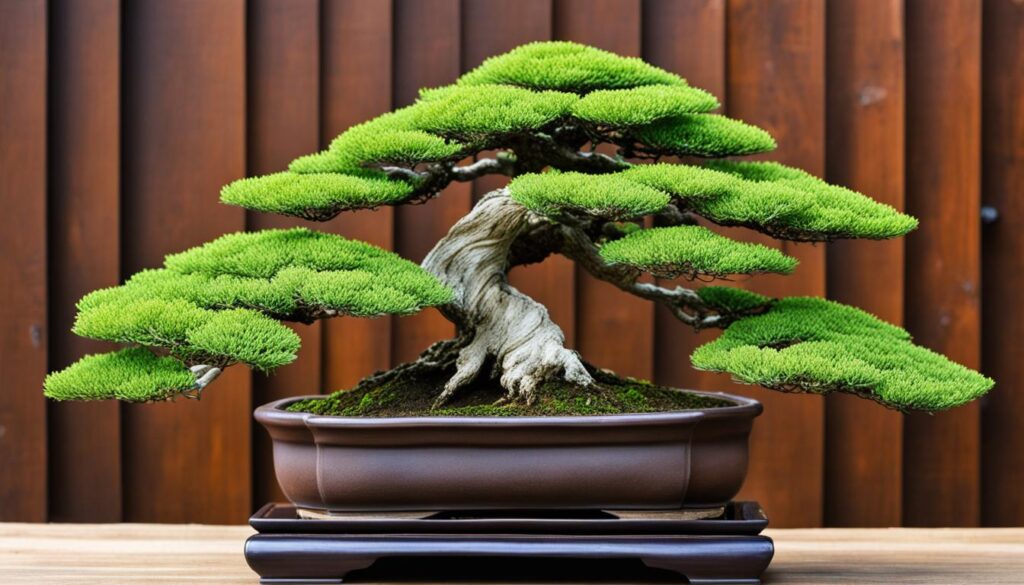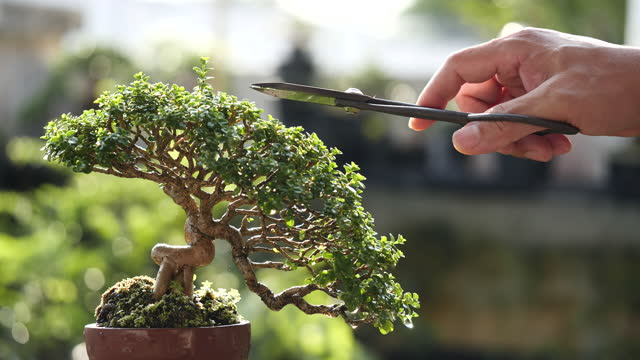The Dwarf Hinoki Cypress, known for its unique features and elegance, requires special attention and care to thrive. Our expert tips and techniques will empower you to nurture your bonsai with confidence and serenity.
In this comprehensive guide, we’ll provide you with all the essential information you need to ensure the health and beauty of your exceptional bonsai masterpiece.
Understanding the Unique Dwarf Hinoki Cypress

In this section, we will talk about the origins, characteristics, and variations of the Hinoki Cypress tree. Understanding these unique aspects will provide valuable insights for cultivating the captivating Dwarf Hinoki Cypress bonsai.
The Majestic Origins and Characteristics of Hinoki Cypress Trees
The Hinoki Cypress, scientifically known as Chamaecyparis obtusa, is an evergreen conifer tree native to Japan. Renowned for its majestic appearance and calming aroma, this tree has a rich cultural significance in Japanese gardens and architecture.
The Hinoki Cypress features a beautiful symmetrical growth pattern, with dense foliage that can range from dark green to a striking golden hue, depending on the variety and age of the tree. The aromatic scent emitted by the foliage adds to its allure.
“The Hinoki Cypress exudes a sense of tranquility and grace, making it a sought-after choice for bonsai enthusiasts.”
The Hinoki Cypress can grow to impressive heights, reaching up to 115 feet (35 meters) in its full-size variety. It possesses a straight-trunked structure, with bark that begins as reddish-brown when the tree is young and transforms into a distinctive reddish-brown with pronounced furrows as it matures.
Distinguishing Between Full-Size and Dwarf Hinoki Cypress Varieties
When it comes to bonsai cultivation, understanding the differences between full-size and dwarf varieties of the Hinoki Cypress is crucial. While both types share many similarities in terms of appearance and characteristics, the dwarf Hinoki Cypress offers distinct advantages for those seeking to create bonsai masterpieces.
The full-size Hinoki Cypress is undeniably stunning, but its towering height makes it challenging to maintain as a bonsai. On the other hand, the dwarf Hinoki Cypress, as the name suggests, is a compact version of the tree that is perfect for bonsai cultivation. The dwarf variety maintains the impeccable features of the full-size tree but in a more manageable size, allowing for greater artistic expression and easier care.
| Full-Size Hinoki Cypress | Dwarf Hinoki Cypress | |
|---|---|---|
| Height | Up to 115 feet (35 meters) | Approximately 2-4 feet (60-120 cm) |
| Trunk Diameter | Thick | Delicate and slender |
| Foliage | Abundant and voluminous | Densely packed and proportional to the tree’s size |
| Bark | Reddish-brown with pronounced furrows | Similar to full-size variety |
Choosing the dwarf Hinoki Cypress for your bonsai not only offers ease of care but also allows for greater versatility in shaping and training the tree. Its delicate trunk diameter and proportional foliage contribute to its overall visual appeal, making it an ideal choice for both beginners and experienced bonsai enthusiasts.
Essential Location and Sunlight Requirements for Your Hinoki Cypress
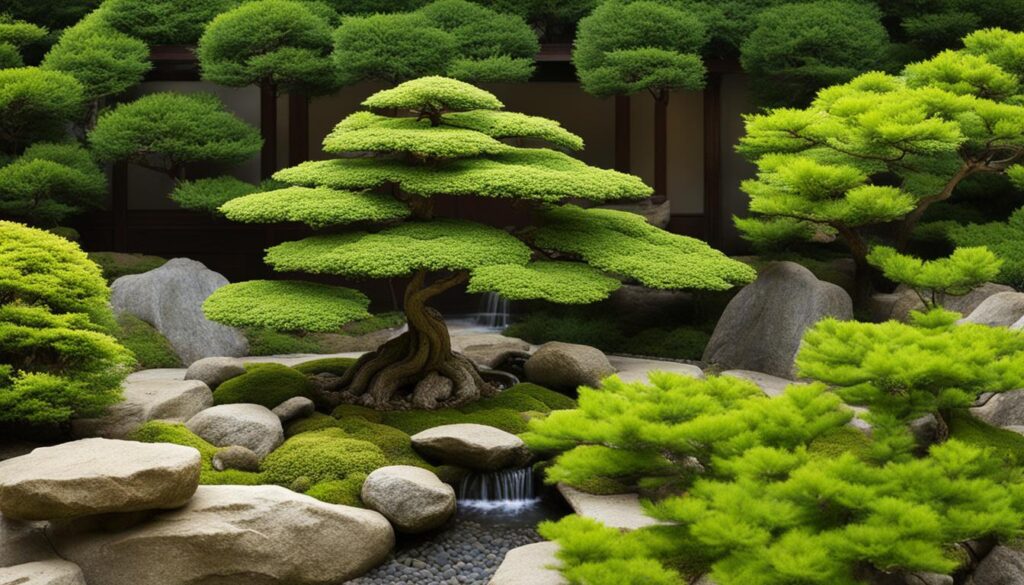
Proper location and sunlight play a crucial role in the health and growth of your Hinoki Cypress bonsai. By understanding the optimal outdoor placement and seasonal light exposure, you can ensure the vitality and beauty of your bonsai tree.
Choosing the Optimal Outdoor Placement for Growth and Aesthetics
When selecting the location for your Hinoki Cypress bonsai, consider both its growth requirements and aesthetic appeal. Here are some factors to keep in mind:
- Light exposure: Hinoki Cypress thrives in locations with partial to full sunlight. Place your bonsai in an area where it can receive at least 4-6 hours of direct sunlight per day. Avoid placing it in full shade or intense, scorching sunlight.
- Protection from elements: Protect your bonsai from strong winds, as they can damage the delicate foliage. Consider placing it near a windbreak, such as a wall or taller plants, to shield it.
- Air circulation: Ensure proper air circulation around your bonsai by avoiding congested areas or corners. This will help prevent the development of fungal diseases and ensure the health of your tree.
- Visual impact: Choose an outdoor location that complements the aesthetic beauty of your Hinoki Cypress bonsai. Consider factors such as garden design, color coordination, and creating a focal point within your outdoor space.
Seasonal Light Exposure: Balancing Summer Growth and Winter Protection
Managing seasonal light exposure is crucial to strike a balance between summer growth and winter protection for your Hinoki Cypress bonsai. Here’s what you need to know:
- Summer growth: During summer, ensure your bonsai receives sufficient sunlight for healthy foliage growth. Monitor the light intensity and duration to avoid sunburn and excessive dehydration. Consider providing shade during peak summer months to protect your bonsai.
- Winter protection: As winter approaches, protect your Hinoki Cypress bonsai from harsh winter conditions. Provide shelter from freezing temperatures, drying winds, and excessive snow. Consider moving your bonsai indoors or providing a protective covering, such as burlap, to shield it from winter stress.
- Year-round care: Throughout the year, monitor the light exposure of your bonsai and make adjustments as needed based on the changing seasons. Regularly observe the health and vitality of your Hinoki Cypress and make necessary adaptations to optimize its growth and overall well-being.
By carefully considering the location and sunlight requirements of your Hinoki Cypress bonsai, you can create an ideal environment that promotes its growth, health, and aesthetic appeal.
Proper Watering Techniques for Hinoki Bonsai Health
Watering is a critical aspect of bonsai care, and understanding the proper watering techniques for your Hinoki Cypress bonsai is essential. Maintaining the right balance of moisture is vital for the health and vitality of your bonsai tree.
When watering your Hinoki Bonsai, it is important to consider the following:
- Frequency: Water your bonsai tree when the topsoil begins to feel slightly dry. This ensures that the roots receive adequate moisture while preventing waterlogged soil.
- Amount: Water your bonsai thoroughly to ensure that the entire root system receives moisture. Allow the water to soak through the soil and drain out from the bottom of the pot.
- Soil Type: Use well-draining soil to prevent water from pooling and causing root rot. A mix of akadama, pumice, and lava rock is commonly used for Hinoki Cypress bonsai.
- Watering Tools: Use a watering can with a fine rose or a misting spray bottle to evenly distribute water across the foliage of your bonsai tree.
It is important to note that overwatering or underwatering can be detrimental to the health of your Hinoki Cypress bonsai. Overwatering can lead to root rot, while underwatering can cause drought stress. It is essential to find the right balance and adjust your watering routine based on the specific needs of your bonsai tree.
By mastering the proper watering techniques, you will be able to provide the optimal conditions for your Hinoki Cypress bonsai, supporting its growth and ensuring its long-term health and beauty.
Nutrient Management: Fertilizing Your Hinoki Cypress Bonsai
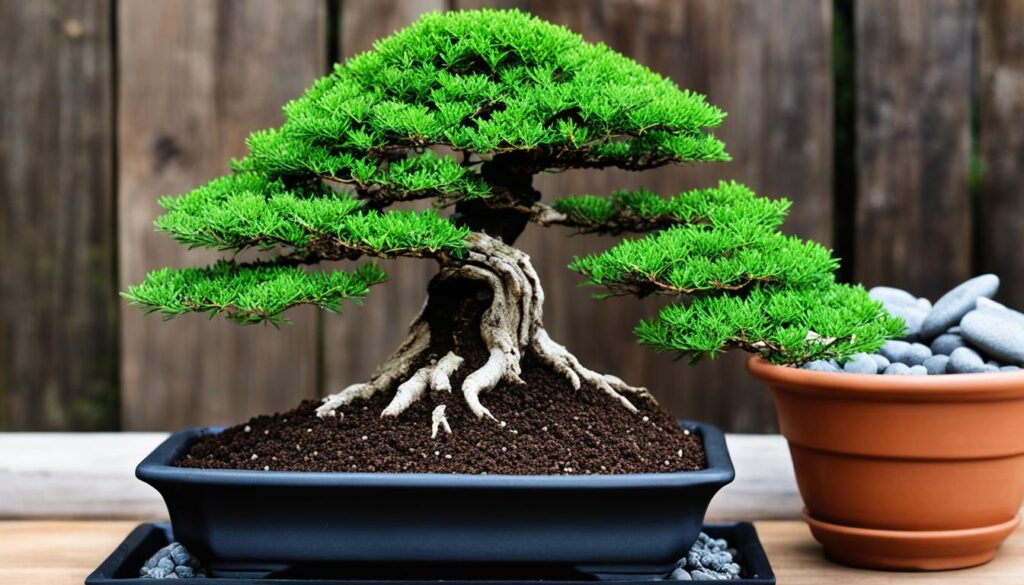
Fertilizing is crucial for the proper growth and development of your Hinoki Cypress bonsai. To ensure optimal growth, it is important to select the right fertilizer that provides the necessary nutrients for your bonsai tree. When choosing a fertilizer, consider factors such as nutrient composition and pH level.
To achieve healthy and vibrant growth, it is recommended to use a balanced bonsai fertilizer with an NPK ratio of 10-10-10 or similar. This balanced ratio ensures that your Hinoki Cypress bonsai receives all the essential macronutrients: nitrogen (N), phosphorus (P), and potassium (K). These macro nutrients support overall growth, root development, and flowering.
Additionally, consider using a slow-release fertilizer to provide a consistent and gradual nutrient supply over time. This helps prevent nutrient imbalances and minimizes the risk of burning the roots.
It is important to fertilize your Hinoki Cypress bonsai at the right time and frequency. During the growing season, typically from spring to early autumn, fertilize your bonsai every two to four weeks. This ensures that your bonsai receives a steady supply of nutrients for healthy growth. However, reduce or eliminate fertilization during the dormant season, usually in late autumn and winter, as the tree’s metabolic activities slow down.
Remember to always follow the manufacturer’s instructions for the specific fertilizer you are using, as different brands may have varying application rates and guidelines.
| Fertilizer | NPK Ratio | Application Frequency |
|---|---|---|
| Brand A Bonsai Fertilizer | 10-10-10 | Every 2 weeks during the growing season |
| Brand B Bonsai Fertilizer | 12-6-6 | Every 4 weeks during the growing season |
| Brand C Bonsai Fertilizer | 8-12-6 | Every 3 weeks during the growing season |
Maintaining the Aesthetic: Pruning and Wiring Techniques
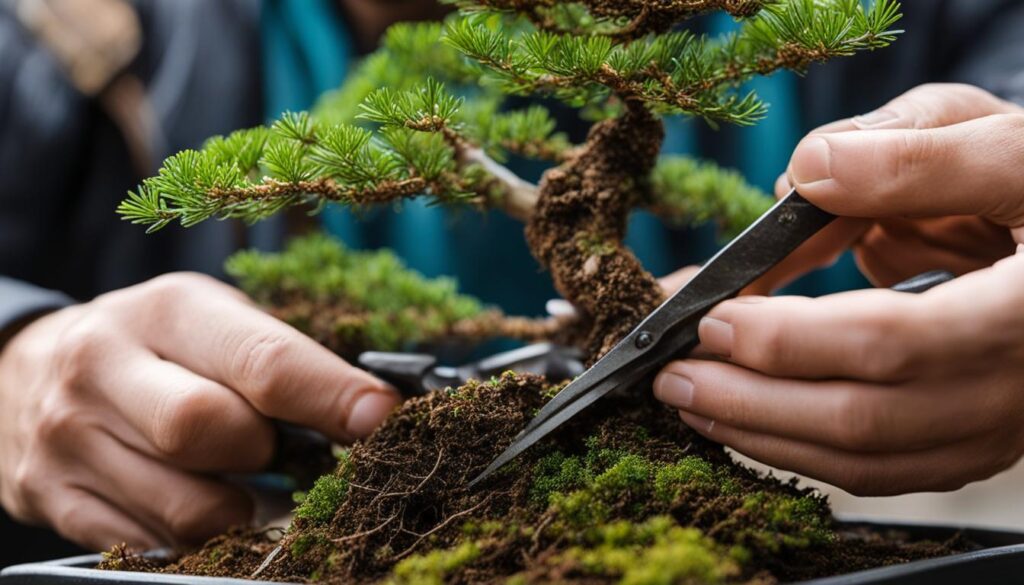
Pruning and wiring are essential techniques for maintaining the aesthetic appeal of your Hinoki Cypress bonsai. By carefully pruning and shaping the tree’s branches, you can create a visually harmonious and balanced bonsai. Additionally, wiring allows you to enhance the overall structure and design of your bonsai tree. Let’s explore these techniques in detail.
Pruning Techniques:
Pruning is the process of selectively removing branches, foliage, and buds to maintain the desired shape and size of your Hinoki Cypress bonsai. It helps create a more refined silhouette and encourages healthy growth. Here are some pruning techniques to consider:
- Branch Pruning: Regularly prune your bonsai tree to remove any unwanted or excess branches. This helps maintain the tree’s overall shape and prevents overcrowding.
- Foliage Pruning: Trim the foliage to maintain balance and proportion. Remove any dead, damaged, or yellowing leaves to promote new growth.
- Bud Pruning: Pinch or prune buds to control the direction and growth of branches. This technique encourages back budding and helps develop a more compact tree.
Wiring Techniques:
Wiring is the process of applying specialized bonsai wire to gently shape and position the branches of your Hinoki Cypress bonsai. It allows you to create precise curves and angles, enhancing the tree’s overall aesthetics. Here’s how to apply wiring techniques:
- Selecting the Right Wire: Choose a wire that matches the thickness and flexibility of the branch. Aluminum or annealed copper wire are commonly used for Hinoki Cypress bonsai.
- Wrapping the Wire: Starting from the base, gently wrap the wire around the branch, following its natural curve. Avoid wrapping too tightly to prevent damage.
- Bending and Positioning: Carefully bend and position the wired branches to achieve the desired shape and aesthetic appeal. Take your time and make adjustments as needed.
- Monitoring and Removing the Wire: Check the wired branches regularly to avoid wire cutting into the bark. Once the branches have set in the desired position, remove the wire carefully.
To visually illustrate the process of pruning and wiring techniques, here’s an image of a beautifully maintained Hinoki Cypress bonsai:
By incorporating these pruning and wiring techniques into your regular Hinoki Cypress bonsai care routine, you can effectively maintain and enhance its aesthetics, ensuring a visually captivating and well-balanced bonsai tree.
The Delicate Process of Repotting Hinoki Cypress Bonsai

Repotting your Hinoki Cypress bonsai is an essential step in its care and maintenance. This delicate process requires careful attention to ensure the health and vitality of your bonsai tree.
When it comes to repotting, timing is crucial. It’s best to repot your Hinoki Cypress bonsai every two to three years, preferably in early spring before the new growth begins. This allows the tree to establish new roots and recover from any potential root damage during the repotting process.
Before repotting, gather the necessary materials, including a suitable soil mix. Hinoki Cypress bonsai trees prefer a well-draining soil that provides adequate moisture retention. A good soil mix can consist of a blend of Akadama, pumice, and lava rock.
Start the repotting process by gently removing the bonsai from its current pot. Carefully loosen the roots, ensuring you don’t damage them in the process. Trim any overly long or damaged roots using sharp pruning shears.
Place a layer of fresh soil mix at the bottom of the new pot. Position the bonsai tree on top of the soil, making sure it is centered and at the desired height. Fill the gaps between the roots with the soil mix, being mindful not to leave any air pockets.
Once the bonsai is securely repotted, water it thoroughly to settle the soil around the roots. Avoid placing the bonsai in direct sunlight immediately after repotting as it may increase the risk of stress and dehydration. Instead, place it in a shaded area for a few weeks to allow it to recover.
Remember to monitor your bonsai’s water needs carefully during the post-repotting phase. The newly repotted tree may require slightly less water as the roots adjust and establish themselves in the fresh soil.
By following these step-by-step instructions and providing the necessary care and attention, you can successfully repot your Hinoki Cypress bonsai, promoting its growth, health, and overall beauty.
Hinoki Cypress: Dealing with Pests and Diseases
Just like any other plant, Hinoki Cypress bonsai trees are susceptible to pests and diseases. It’s important to be proactive in identifying, preventing, and managing these issues to ensure the health and longevity of your bonsai tree.
Common pests that can affect your Hinoki Cypress bonsai include aphids, spider mites, and scale insects. These tiny creatures can cause damage to the foliage and weaken the overall health of your tree. Regularly inspect your bonsai for any signs of infestation, such as sticky residue on the leaves, webbing, or tiny insects. If you spot any pests, take immediate action to eliminate them. There are various pest control methods available, including natural remedies, insecticidal soaps, and horticultural oils. Choose the method that suits your preferences while considering the well-being of your bonsai.
When it comes to diseases, Hinoki Cypress bonsai trees can be affected by fungal infections like root rot and powdery mildew. These diseases thrive in moist and humid conditions, so it’s important to maintain proper watering practices to prevent their development. Avoid overwatering your bonsai and ensure good drainage. If you notice any signs of disease, such as wilting leaves, discoloration, or powdery growth, take immediate action. Treatments may involve removing affected areas, using fungicides, or adjusting cultural practices, depending on the specific disease.
To effectively manage pests and diseases, it’s crucial to stay vigilant and regularly monitor your Hinoki Cypress bonsai. Keep a close eye on the health of your tree, and take steps to prevent any potential issues. By selecting the right pest control methods and disease management techniques, you can create a healthy and thriving environment for your bonsai, ensuring its beauty for years to come.

